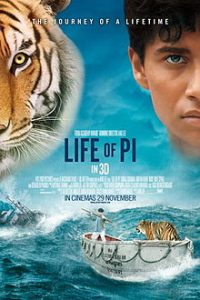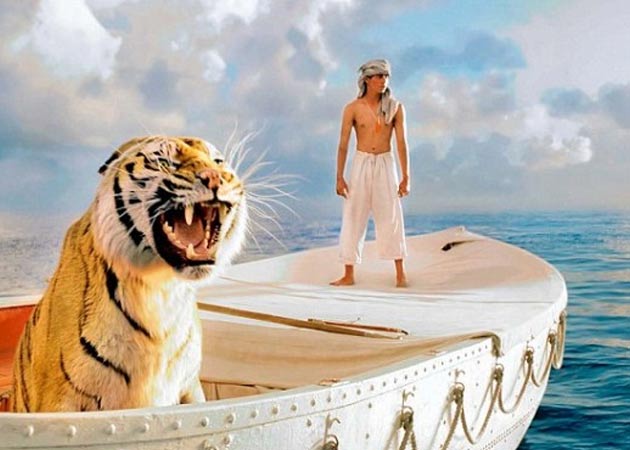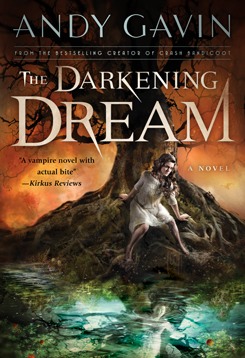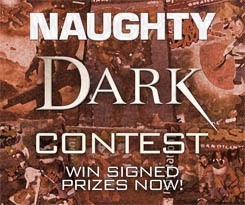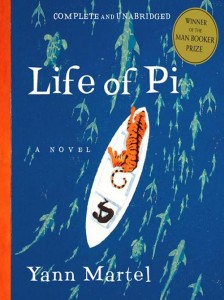 Title: Life of Pi
Title: Life of Pi
Author: Yann Martel
Genre: Literary Adventure
Read: November 18-20, 2013
Summary: Effective and Affecting
The film version of Life of Pi stuck with me for days. I’m fascinated by the transmutation stories undergo from one medium to another, and in the middle of adapting my own novel Untimed, so I picked up the book. Plus, when a film is based on a novel, the later is usually superior.
This is true here. The book is deeper and its allegorical presentation much clearer, but the film translation is decidedly faithful and effective (I discuss my initial impressions of the movie here). In this article I’ll focus on two main points: my perception of the meaning of the book, and the process of film adaption relative to the book. I will not go into the plot, as that’s been covered before.
As Pi himself comments, you have two alternate versions of the same story presented. In both, a ship sinks, everyone but Pi dies, and most of a year later he washes up in Mexico. Neither version makes any effective difference for anyone else in the world. When Pi asks the Japanese investigators to whom he tells these tales which is the better story, they chose the one with the tiger. Pi observes, “so it goes with God.”
This is the crux of the book’s double allegory. The Richard Parker (or animal) story can be seen as an interpretation for the unacceptably horrific “more realistic” story. I’ll discuss that in a second, but more fundamentally, the whole double tale can be seen as an allegory for faith, for the very act of seeing the universe as God(s)’ work (true be there one, three, or infinite gods). When faced with the hard cruel story, Pi chooses the miraculous interpretation – and so do most people.
This central thesis is the weakest part of the film, which generally does a wonderful job with both the introduction and the harrowing animal allegory itself. In the novel, the parallels between the animal and human tales are more numerous and clear. Both tales are more horrifying, the human one doubly so. This subtle tonal shift is absolutely crucial when we come to the choice and juxtaposition between tales. Each reader/viewer choose for himself what to believe (“and so it goes with God”). The film leans this choice more heavily toward Richard Parker as its compressed telling of the human tale does not do justice to Martel’s careful construction of the internal allegory.
Still, I can not emphasize too much, given the limitations of both mediums, how terrific an adaptation of this wonderful novel the film is. The book is more personal, internal, philosophical, realistic even. Martel did some serious research and every bit of Pi’s life, particularly the time on the boat feels very real. He sells this story as effectively as one possibly could. And despite musings, philosophy, asides, and copious detail does it in an immersive and gripping way. I stayed up to 4am to read the final 2/3 of the novel in one go.
The film, for its part, is more visually arresting, more luminous and surreal. The writer, director, and actors have constructed scenes where only narrative existed, and brought them to life with great color. Even the fairly elaborate build up is transmuted essentially intact. There are nips and tucks. We lose a minor characters as their dialog folds into more important ones. Richard Parker is introduced earlier, picking up a crucial scene from another tiger. For the most part, these tie the story tighter to the central narrative. A process crucial to which films adaption. A few changes are more mysterious: 1) a brief love interest is introduced in the film and 2) Pi’s father becomes a less competent zookeeper. They don’t detract in a serious way, but I didn’t see the point.
In the central portion, the bookish Pi’s musings on what it takes to survive the ordeal, and his detailed walk through of many details (including turtle butchery, hunger, and dining on excrement, etc.) is effectively replaced by specific moments and young Pi’s wry narration and gifted facial expressions. But this weakens what Richard Parker represents in the interior allegorical interpretation. He servers as Pi’s animal nature, his will to survive, and the film doesn’t dare show that as graphically as the novel does. Likewise the odd “two blind men” sequence in the novel is deleted. This had to be done, as it has no real place in a film, and was the dullest section of the book. Still, it serves to bind the two versions of the crossing together, completing the allegory.
The novel’s POV trick in the third section, where it switches to the Japanese investigator’s report, also helps provide the proper balance for evaluating the allegorical positions. In the film, we remain more tightly with Pi, and hence with the Richard Parker version. But POV is the novel format’s biggest gun. It enables voice and interior monologue. Proper POV in a novel is as crucial as casting in a film, as both must shoulder the emotional burdens.
Any which way, read the book, see the movie, or both.

